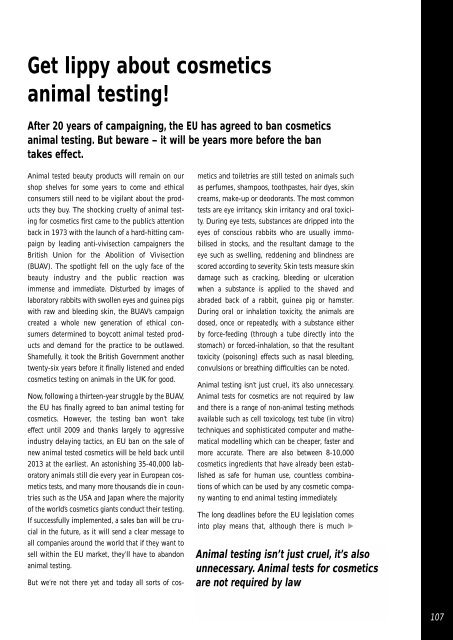GREEN GUIDE - Markham Publishing
GREEN GUIDE - Markham Publishing
GREEN GUIDE - Markham Publishing
Create successful ePaper yourself
Turn your PDF publications into a flip-book with our unique Google optimized e-Paper software.
Get lippy about cosmeticsanimal testing!After 20 years of campaigning, the EU has agreed to ban cosmeticsanimal testing. But beware – it will be years more before the bantakes effect.Animal tested beauty products will remain on ourshop shelves for some years to come and ethicalconsumers still need to be vigilant about the productsthey buy. The shocking cruelty of animal testingfor cosmetics first came to the public’s attentionback in 1973 with the launch of a hard-hitting campaignby leading anti-vivisection campaigners theBritish Union for the Abolition of Vivisection(BUAV). The spotlight fell on the ugly face of thebeauty industry and the public reaction wasimmense and immediate. Disturbed by images oflaboratory rabbits with swollen eyes and guinea pigswith raw and bleeding skin, the BUAV’s campaigncreated a whole new generation of ethical consumersdetermined to boycott animal tested productsand demand for the practice to be outlawed.Shamefully, it took the British Government anothertwenty-six years before it finally listened and endedcosmetics testing on animals in the UK for good.Now, following a thirteen-year struggle by the BUAV,the EU has finally agreed to ban animal testing forcosmetics. However, the testing ban won’t takeeffect until 2009 and thanks largely to aggressiveindustry delaying tactics, an EU ban on the sale ofnew animal tested cosmetics will be held back until2013 at the earliest. An astonishing 35-40,000 laboratoryanimals still die every year in European cosmeticstests, and many more thousands die in countriessuch as the USA and Japan where the majorityof the world’s cosmetics giants conduct their testing.If successfully implemented, a sales ban will be crucialin the future, as it will send a clear message toall companies around the world that if they want tosell within the EU market, they’ll have to abandonanimal testing.But we’re not there yet and today all sorts of cosmeticsand toiletries are still tested on animals suchas perfumes, shampoos, toothpastes, hair dyes, skincreams, make-up or deodorants. The most commontests are eye irritancy, skin irritancy and oral toxicity.During eye tests, substances are dripped into theeyes of conscious rabbits who are usually immobilisedin stocks, and the resultant damage to theeye such as swelling, reddening and blindness arescored according to severity. Skin tests measure skindamage such as cracking, bleeding or ulcerationwhen a substance is applied to the shaved andabraded back of a rabbit, guinea pig or hamster.During oral or inhalation toxicity, the animals aredosed, once or repeatedly, with a substance eitherby force-feeding (through a tube directly into thestomach) or forced-inhalation, so that the resultanttoxicity (poisoning) effects such as nasal bleeding,convulsions or breathing difficulties can be noted.Animal testing isn’t just cruel, it’s also unnecessary.Animal tests for cosmetics are not required by lawand there is a range of non-animal testing methodsavailable such as cell toxicology, test tube (in vitro)techniques and sophisticated computer and mathematicalmodelling which can be cheaper, faster andmore accurate. There are also between 8-10,000cosmetics ingredients that have already been establishedas safe for human use, countless combinationsof which can be used by any cosmetic companywanting to end animal testing immediately.The long deadlines before the EU legislation comesinto play means that, although there is much Animal testing isn’t just cruel, it’s alsounnecessary. Animal tests for cosmeticsare not required by law107



